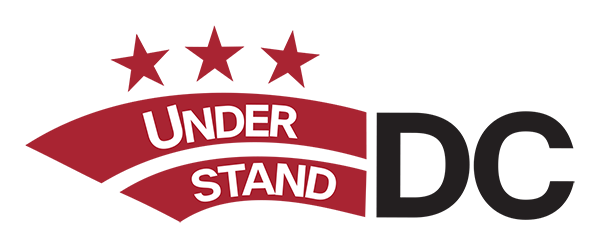What is Special about DC?
DC’s Unique Holiday
Washingtonians have our own holiday—Emancipation Day on April 16th. On that day in 1862, eight months before he issued the Emancipation Proclamation, Abraham Lincoln signed the District of Columbia Compensated Emancipation Act, freeing over 3.000 enslaved people in the District of Columbia and awarding $300 per person to their enslavers.

Even before the war was officially over, African Americans in Washington celebrated the end to slavery, On April 16 in 1866, a parade of 5,000 African Americans representing military battalions, fraternal organizations, church groups, political parties and more marched from Georgetown to the Capitol. When the parade paused at the White House, the marchers were greeted by President Andrew Johnson. Their destination was Franklin Square where they joined 10,000 spectators in celebration, song, and prayer.
Washingtonians continued to celebrate Emancipation Day throughout the nineteenth century. But after 1901, the parades ended because of the growing influence of Jim Crow and dissension in the Black community.
The effort to make Emancipation Day a contemporary DC Holiday was spearheaded by Loretta Carter Hanes, a former reading teacher and executive director of Reading is FUNdamental, which provides free books to young students. In the course of conducting research for the District of Columbia Bicentennial, Ms. Hanes learned about the emancipation of enslaved Washingtonians in 1862 and the19th century celebrations of the event. Her advocacy began with educational programs. She raised awareness and recruited advocates among DC government officials, local organizations, businesses, churches, and schools.
In 2005, DC Emancipation Day became an official holiday in DC. Every year, the holiday is observed at a breakfast hosted by the Mayor, a parade, and an evening celebration with fireworks. At the African American Civil War Memorial, there is a reading of the names of people who were freed in 1862. The DC Public Library, public schools, and universities have programs honoring DC Emancipation Day.
The day of the week that DC Emancipation Day falls on can change the Federal Income Tax filing deadline for all American taxpayers, because the federal government honors District of Columbia holidays. If April 15 falls on a Friday, then Emancipation Day is observed on April 15 (the nearest weekday to Saturday the 16th) and Tax Day becomes the following Monday, April 18. When April 15 falls on a Saturday or Sunday then Emancipation Day is observed on the following Monday and tax returns are due on Tuesday.
Drum Circle

Every Sunday afternoon at 3, the sound of drums, accompanied by tambourines, cowbells, cymbals, and other percussion instruments fills Meridian Hill Park in Northwest DC. The music attracts an appreciative audience and often inspires dancers, acrobats, and other interpreters.
This 60-year drum circle tradition originated as a tribute to Malcolm X. On the day he was assassinated, a group of African American drummers gathered in the park to mourn his loss and honor him. The drummers returned to the park often, and their weekly drum circles became a tradition. The circle became more diverse, and women brought their drums.
The drummers, some of whom have gone on to perform on Broadway or tour with Marvin Gaye or Nina Simone helped sponsor African Liberation Day celebrations and joined the movement to rename the park for Malcolm X. The park’s official name is still Meridian Hill, but many Washingtonians call it Malcolm X Park.
Today, the drum circle welcomes anyone who has something to strike, shake, or scape.
For many of the musicians and observers, the drum continues to be a spiritual experience.
DC’s Own Go-Go Beat
Washington DC is a music town. Here you can enjoy everything from Grand Opera to hip hop. You can also enjoy go-go, the blend of soul and funk with an infectious beat that has become DC’s signature music. Chuck Brown, who became very popular on the Washington music scene in the 60’s, developed the laid-back, rhythm-heavy style of funk. The beat caught on throughout DC neighborhoods, particularly with young people. And with the release of Chuck Brown’s hit record “Bustin Loose,” in 1978, Go-go gained national recognition for a brief period of time.
In DC neighborhoods, enthusiasm for go-go remained high among young people who eagerly formed Go-go bands. Some were able to apply the skills they had acquired in a strong music program at a DC public school or in a high school band. Those who could not afford instruments improvised. In 1980, an enthusiastic group of kids from the Barry Farm Public Housing project formed the Junk Yard Band. They created drums out of empty buckets and traffic cones. For a brass section, they used plastic toy horns. Gradually, real instruments replaced the plastic substitutes, and they were recognized as an outstanding band.
As the Junkyard Band and go-go music gained in popularity, the band had opportunities to play at schools, recreation centers, and fundraisers across the city. It was featured in a local commercial for a men’s clothing store and in the film “D.C. Cab.” In 1985, Junkyard signed a contract with Def Jam Recordings. This led to the recording of “Sardines” which was popular in the late 80’s and became the band’s
Following the song’s success, came a coast-to-coast road tour where the band introduced go-go to admiring audiences.
Today, the Junkyard Band including two of its original members, Moe Shorter and Steven “Buggs: Herrion, performs at Washington area music venues, such as the Howard Theater, Capital One Arena.
In 2020, the DC government passed a law that makes go-go the official music of the District of Columbia. Washington’s new Go-Go Museum opened in Anacostia on February 19. It features live performances, interactive exhibits and historic artifacts.
Additional Resources
- League of Women Voters of the District of Columbia
- League of Women Voters of the District of Columbia on Substack
Top Photo: Ted Eytan on Flickr

